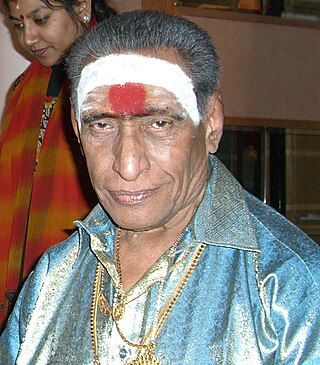
Kunnakudi Vaidyanathan was an Indian classical music violinist and music composer.
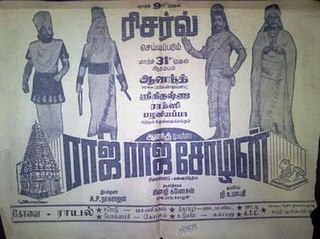
Rajaraja Cholan is a 1973 Indian Tamil-language historical biographical film directed by A. P. Nagarajan and written by Aru Ramanathan. Based on Ramanathan's play of the same name about the life of the Chola king Rajaraja I, the film stars Sivaji Ganesan in the title role and was the first Tamil CinemaScope film. It was released on 31 March 1973, and ran for over 100 days in theatres.

Dharma Yuddam is a 1979 Indian Tamil-language action film directed by R. C. Sakthi. It stars Rajinikanth and Sridevi. The film was released on 29 June 1979.

Thenkarai Ramakrishna Mahalingam born in Sholavandan Thenkarai was an Indian actor and playback singer of the 1940s and 1950s. He was known for his melodious songs mostly based on romantic or devotional themes.

Sirkazhi Govindarajan was a Tamil Carnatic vocalist and a leading playback singer of Tamil and Indian cinema.
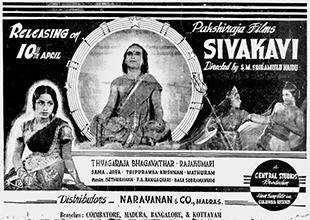
Sivakavi is a 1943 Indian Tamil-language film directed, initially, by P. K. Raja Sandow and later, S. M. Sriramulu Naidu. It starred M. K. Thyagaraja Bhagavathar, S. Jayalakshmi, Serukalathur Sama, Thirupurambal, T. R. Rajakumari, N. S. Krishnan and T. A. Mathuram. The film's screenplay was written by Thiru Muruga Kirubanandha Variyar. The film was shot at Central Studios and released by Pakshiraja Films in Coimbatore. The film was released on 10 April 1943.
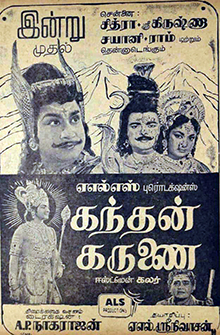
Kandhan Karunai is a 1967 Indian Tamil-language Hindu mythological film, written and directed by A. P. Nagarajan. It features an ensemble cast including Sivaji Ganesan, Gemini Ganesan, K. B. Sundarambal, Savitri, Jayalalithaa, K. R. Vijaya and Sivakumar. This was the debut film for Sridevi, who had starred as Lord Murugan at the age of 3.
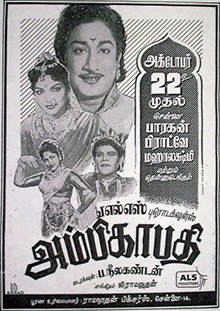
Ambikapathy is a 1957 Indian Tamil language film directed by P. Neelakantan, starring Sivaji Ganesan and P. Bhanumathi. The film, primarily in black-and-white, had sequences in Gevacolor. It was released on 22 October 1957.

Deivam (transl. God) is a 1972 Indian Tamil-language devotional anthology film, starring Gemini Ganesan, R. Muthuraman, A. V. M. Rajan, Srikanth, K. R. Vijaya, Sowcar Janaki, Nagesh and Thengai Srinivasan. The film was edited and directed by M. A. Thirumugam and written by Sandow M. M. A. Chinnappa Thevar. It was released on 4 November 1972.
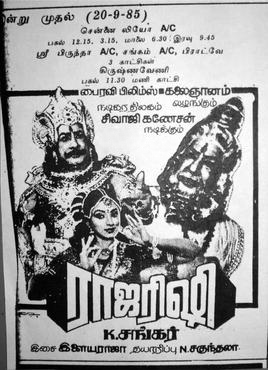
Raja Rishi is a 1985 Indian Tamil-language Hindu mythological film directed by K. Shankar and produced by N. Sakunthala. The film stars Sivaji Ganesan, Prabhu, M. N. Nambiar and Nalini. It is based on the play Viswamithran by A. S. Prakasam, which is about the sage Vishvamitra. The film was released on 20 September 1985, and failed at the box office.
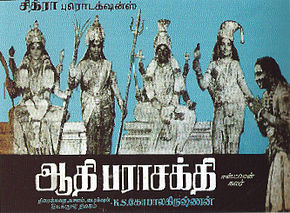
Aathi Parasakthi is a 1971 Indian Tamil-language Hindu mythological film written and directed by K. S. Gopalakrishnan. It stars S. Varalakshmi in the title role, Gemini Ganesan and Jayalalithaa. Sridevi acted as a child artist, while Padmini came in for a cameo. The film was dubbed in Hindi as Jai Jagat Janani (1976).

Thaai Mookaambikai is a 1982 Indian Tamil-language devotional film directed by K. Shankar, starring K. R. Vijaya, Jaishankar, Sivakumar, Sujatha and other leading actors. The film was released on 9 July 1982.

Thirumalai Thenkumari is a 1970 Indian Tamil-language film written and directed by A. P. Nagarajan. Inspired by the 1969 film If It's Tuesday, This Must Be Belgium, it features an ensemble cast consisting of Sivakumar, Kumari Padmini, Rama Prabha, Shylashri, Manorama, Sirkazhi Govindarajan and Suruli Rajan. The film focuses on a group of passengers who embark on a pilgrimage across South India. It was released on 15 August 1970, emerged a commercial success, and won three Tamil Nadu State Film Awards.
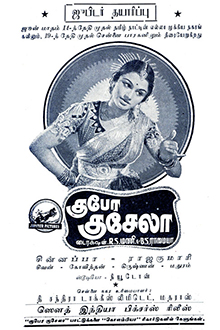
Kubera Kuchela is a 1943 Indian Tamil-language Hindu mythological film directed by R. S. Mani and written by B. S. Ramaiah. The soundtrack was by Kunnakudi Venkatarama Iyer and background music by S. V. Venkat Raman. The film stars P. U. Chinnappa T. R. Rajakumari, D. Balasubramaniam and P. S. Govindan.
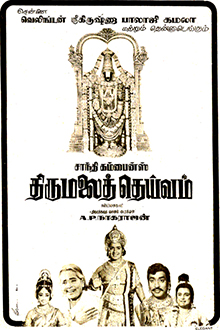
Thirumalai Deivam is a 1973 Indian Tamil-language Hindu mythological film, directed and written by A. P. Nagarajan. The film stars Sivakumar in the title role, with K. B. Sundarambal, T. R. Mahalingam, Srividya, Lakshmi and A. V. M. Rajan in supporting roles.

Vaa Raja Vaa is a 1969 Indian Tamil-language children's film written, directed and produced by A. P. Nagarajan for CNV Productions. The film features an ensemble cast including Master Prabhakar, Baby Sumathi, Sirkazhi Govindarajan, V. S. Raghavan, K. D. Santhanam and Suruli Rajan. It was released on 6 December 1969 and became a commercial success. The film was remade in Telugu as Balaraju Katha (1970), with Prabhakar reprising his role.

This is the Tamil discography of veteran Indian male playback singer K. J. Yesudas, who sang in over 700 songs in Tamil films. He Sang the most in Tamil. Yesuda's first film was in the film Bommai (1963) as Neeyum Bommai Naanum Bommai composed by S. Balachander.

This is the discography of Indian male playback singer Sirkazhi Govindarajan, who sang in over 900 songs in Tamil films. He mostly sang in Tamil Film Songs and Devotional Songs. He gave his voice to actors and thespians in the Tamil film industry such as M. G. Ramachandran, Gemini Ganesan, S. S. Rajendran, R. Muthuraman, K. A. Thangavelu, V. Nagayya, Prem Nazir, Kalyan Kumar, Nagesh In addition to various other known and unknown heroes and supporting actors like R. S. Manohar, S. V. Subbaiah, Kannadasan, Kuladeivam Rajagopal, Major Sundarrajan, Thengai Srinivasan, Suruli Rajan, Master Prabhakar.

Kannan Oru Kai Kuzhandhai is a 1978 Indian Tamil-language film directed by N. Venkatesh and produced by Tirupur Mani. The film stars Sivakumar and Sumithra. It was released on 8 September 1978, and did not do well at the box-office.

This is the Tamil discography of veteran Indian female playback singer P. Susheela, who sang in over 6000 songs in Tamil. She gave her voice to actresses and thespians in the Tamil Film Industry such as Padmini, B. Saroja Devi, Jayalalitha.



















